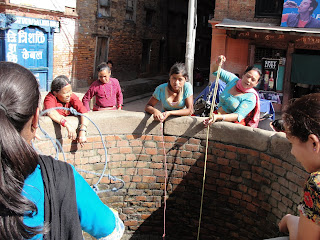Water Shortage & Well Washing Festival by Keesler
While in Nepal for the summer my research project entails investigating the management of water here in the Kathmandu Valley. In this increasingly dense capital, there is more demand for water than there is supply. Defining factors that have led to the increased water crisis in the Kathmandu Valley in recent years include: an unchecked boom in population, urbanization and industrialization, a disregard to the over drawing of groundwater, and the pollution of river waters. Furthermore, having access to improved water sources does not mean that water is always available in sufficient quantity since many households do not receive a regular supply, particularly during the dry season. At present, the demand for water in Kathmandu is approximately 200 million liters per day but during the dry season, the water authority ‘Kathmandu Upatyaka Khanepani Limited’ (KUKL) can supply only 90 million liters per day (45%) and 120 million liters per day (60%) during the wet season (UN HABITAT, 2008). Even at my host family’s house and my fellow students’ host families, everyone is urged to take quick showers due to the water supply shortage.
On June 17th, people of the Newari community around Kathmandu celebrated Sithi Nakha, which is a day for cleaning the wells, water sprouts, taps, and water pipes before the monsoon rains come. I was told that Kathmandu used to be a lake bed, and since water percolates through the walls of the wells, they need to be cleaned thoroughly so that the walls do not get cemented. The day June 17th was chosen because that is when the water levels are the lowest. My group was able to go on a heritage walk around the district of Patan where I was able to take pictures of these wells before the Sithi Nakha festival.




According to the Kathmandu Post, the Newari community has demanded the government address water woes:
While here I hope to disentangle the many actors and stakeholders within the management of water throughout the Kathmandu Valley. That includes looking into: public private partnerships (PPPs), community-based water supply systems, public companies registered under the Government of Nepal, the largely unregulated privately-owned water supply services, and the role of INGOs and NGOs. There has been an increasing need for effective management of the water supply systems within Kathmandu in order to provide water for all.
Boy do I have a lot on my plate for this summer….. =)
There are so many metaphors coming up after your last comment -- "but you are going to quench your thirst for knowledge" haha
ReplyDeleteThis is such an important subject to be studied in Kathmandu. Especially as I contemplated the sad state of the Baghmati River coming over the bridge back from Lalitpur just now; the pungency of smell that I have never experienced near a single body of water before. It makes one wonder what all of the phenomena surrounding the river had to occur to drive it to such a condition.
This is one daily thought among many about water being in this city, alongside the constant need and search for bottled water that has become a second nature now.
You'll do great research!
Dee